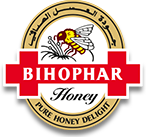Common questions
The consistency of honey depends primarily on the combination of natural sugars for the nectar and pollen type. If a honey contains an especially large amount of fruit sugar (fructose), it stays runny. On the other hand, if it contains more dextrose/glucose it will crystallise soon after harvesting. The enzymes in honey also convert the sugar, which means that long chains of glucose are broken down and separated from the honey. Therefore crystallisation occurs over time. The honey becomes more solid the longer it is stored.
Only honey that has been produced according to strictly-defined criteria can be described as organic honey. Beekeepers who farm organically may only let their bees fly around in uncontaminated areas. Their beehives mainly consist of natural materials, for example wooden boxes. To combat disease, organic farmers predominantly use natural substances and avoid synthetic chemical treatments. As winter feed the bees receive their own honey and pollen. Here you'll find more information on organic beekeeping.
If stored correctly, honey can be kept indefinitely. Honey has even be found in the Egyptian Pyramids as a burial gift. Although it dates from 3,200 BC, it can still be eaten today. However when honey is stored inappropriately for long periods it loses some of its valuable constituents.
Honey should be protected from light and stored at room temperature. As honey quickly absorbs foreign odours and has a strong tendency to absorb moisture (hygroscopic), it is best to store it in a tightly-closed glass.
During storage honey crystallises and becomes solid. This is a natural process and doesn't affect the quality. If you prefer your honey to be liquid, you can carefully warm it up in a pan of water. The temperature must remain under the beehive temperature of 40 °C, so that the heat-sensitive ingredients of the honey are not damaged.
To produce 1 kg of honey, a bee must collect ca. 3 kg of nectar. In order to gather this volume of nectar, the bee must visit 15 million flowers. This translates to a distance of approximately 160,000 km and means that it flies almost four times around the Earth.
When harvesting the individual varieties, such as rapeseed honey and acacia honey, the beekeeper can rely on the bees' loyalty to each variety of pollen and nectar. For bees continue to gather nectar or honeydew from the same plants until the supplies are exhausted. To harvest rapeseed honey, for example, the beekeeper installs his hives on large rapeseed fields. He observes the bees and can recognize from the traces of pollen on their bodies whether they are actually visiting the right plants. The extent to which a honey is characteristic of an individual variety can be measured through a pollen analysis.
Honey consists of 80 % natural sugar. This is primarily valuable, natural glucose and dextrose, which pass into the blood particularly easily and deliver energy quickly. In contrast to conventional refined household sugar, honey additionally contains several proteins, minerals and low volumes of vitamins. An important factor is that the enzymes and inhibins in honey make it a particularly valuable sweetener.
From the age of one children can enjoy honey without any problem. In younger infants the intestinal flora (bacteria and other organisms) and therefore the immune system is not fully developed. As honey is a natural product, it can, just like other raw food, contain spores of Clostridium botulinum in rare cases. This is present everywhere in our environment. These bacteria spores, which are harmless for adults, can cause dangerous infant botulism in infants. Therefore, as a precaution, children under 1 year old should not eat honey.
Depending on the severity of their diabetes, diabetics can also enjoy small amounts of honey in consultation with their doctor. Honey contains up to 35-40% fructose (fruit sugar), which passes more slowly into the blood and is therefore better for diabetics. On the other hand honey also contains 30-35% glucose (grape sugar/dextrose), which raises the blood sugar level faster. Honey varieties with a high fructose content are therefore recommended for diabetics. These are primarily the liquid honey varieties, such as acacia honey. In any case diabetes should discuss their diet and the inclusion of honey with their doctor.
